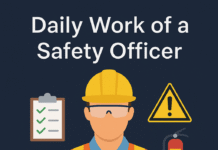
Introduction
How to Become HSE Manager : Health, Safety, and Environment (HSE) management is a critical aspect of various industries, ensuring the well-being of employees and safeguarding the environment. As an HSE manager, you play a pivotal role in overseeing and implementing safety protocols, risk assessments, and environmental policies within an organization. If you aspire to become an HSE manager, this article will guide you through the necessary steps and skills required to succeed in this rewarding and challenging career path.
How to Become HSE Manager
Understanding the Role of an HSE Manager
1.1 What is HSE Management?
Health, Safety, and Environment (HSE) management is a multidisciplinary field that focuses on safeguarding the well-being of employees, contractors, and the community while ensuring environmental conservation within an organization.
1.2 Responsibilities of an HSE Manager
As an HSE manager, you will be responsible for developing, implementing, and overseeing safety policies and procedures. Your role involves identifying potential hazards, conducting risk assessments, and ensuring compliance with relevant regulations.
Developing Educational Background and Skills
2.1 Educational Requirements
To become an HSE manager, a bachelor’s degree in occupational health and safety, environmental science, or a related field is usually required. Some employers may prefer candidates with a master’s degree for senior positions.
2.2 Certifications and Training
Acquiring certifications such as Certified Safety Professional (CSP), Occupational Health and Safety Technologist (OHST), or Certified Hazardous Materials Manager (CHMM) can significantly enhance your prospects in the HSE field.
2.3 Key Skills for HSE Managers
Successful HSE managers possess excellent communication, leadership, problem-solving, and analytical skills. Additionally, attention to detail, adaptability, and the ability to work under pressure are crucial traits.
Gaining Work Experience
3.1 Starting as an HSE Intern
Begin your HSE career as an intern or entry-level HSE officer to gain practical experience and insight into the industry.
3.2 Progressing to HSE Officer
As you accumulate experience, you can advance to the role of an HSE officer, responsible for implementing safety programs and conducting regular inspections.
3.3 Climbing the Ladder to HSE Manager
Demonstrate your expertise, leadership, and commitment to safety to secure a position as an HSE manager.
Understanding Industry-Specific Regulations
4.1 OSHA Standards
Familiarize yourself with Occupational Safety and Health Administration (OSHA) standards, as they play a vital role in workplace safety regulations.
4.2 Environmental Protection Guidelines
Understand the environmental protection guidelines set by regulatory bodies to ensure the organization’s compliance with eco-friendly practices.
Risk Assessment and Mitigation Strategies
5.1 Identifying Potential Hazards
Conduct comprehensive risk assessments to identify potential hazards within the workplace.
5.2 Analyzing and Prioritizing Risks
Analyze the identified risks and prioritize them based on their severity and potential impact.
5.3 Implementing Mitigation Plans
Develop and implement mitigation strategies to minimize or eliminate identified risks.
Implementing Safety Protocols
6.1 Creating and Implementing Safety Policies
Develop clear and concise safety policies and ensure their effective implementation throughout the organization.
6.2 Conducting Safety Training Programs
Organize regular safety training programs to educate employees about potential hazards and safe working practices.
6.3 Ensuring Compliance with Safety Standards
Monitor and enforce compliance with safety standards and regulations, fostering a culture of safety and accountability.
Emergency Response and Crisis Management
7.1 Developing Emergency Response Plans
Create comprehensive emergency response plans to handle potential crises effectively.
7.2 Conducting Mock Drills and Exercises
Regularly conduct mock drills and exercises to test the efficiency of emergency response plans.
7.3 Handling Crisis Situations Effectively
In times of crisis, remain calm and take decisive actions to ensure the safety of all personnel and assets.
Communication and Leadership
8.1 Effective Communication Skills
Develop strong communication skills to convey safety messages clearly to all levels of the organization.
8.2 Building a Safety-Conscious Culture
As an HSE manager, one of your key responsibilities is to foster a safety-conscious culture within the organization. This involves leading by example and emphasizing the importance of safety at all levels. Encourage open communication channels where employees can freely report hazards or near-miss incidents without fear of retribution. By promoting a culture that prioritizes safety, you can create a work environment where everyone feels responsible for their well-being and that of their colleagues.
8.3 Motivating and Inspiring the Team
Motivation plays a vital role in maintaining a high level of safety awareness. As an HSE manager, inspire your team to embrace safety as a core value by recognizing and rewarding their efforts towards safety excellence. Organize safety appreciation events, acknowledge safety achievements publicly, and provide incentives for safe practices. A motivated team is more likely to actively participate in safety initiatives and take ownership of their safety responsibilities.
Staying Updated with Industry Trends
9.1 Attending Workshops and Conferences
The field of HSE is constantly evolving, with new regulations and best practices emerging regularly. Attend workshops, conferences, and seminars related to HSE management to stay updated with the latest industry trends and innovations. Networking at such events can also provide valuable insights and opportunities for collaboration.
9.2 Subscribing to HSE Journals and Publications
Subscribe to reputable HSE journals and publications to access expert articles, research papers, and case studies. These resources can offer valuable information on new techniques, technologies, and successful HSE strategies implemented by other organizations.
9.3 Networking with HSE Professionals
Build a strong professional network by connecting with other HSE professionals. Networking allows you to exchange ideas, seek advice, and gain different perspectives on various HSE challenges and solutions. Join online forums and HSE-related social media groups to engage with a broader community of experts.
Evaluating HSE Performance
10.1 Metrics and Key Performance Indicators (KPIs)
Establish measurable metrics and Key Performance Indicators (KPIs) to track the effectiveness of HSE initiatives. Analyze data regularly to identify areas for improvement and make data-driven decisions to enhance safety performance.
10.2 Continuous Improvement Strategies
HSE management is an ongoing process, and continuous improvement is essential. Encourage a culture of continuous learning and improvement within your team. Regularly assess and adjust safety strategies to adapt to changing circumstances and ensure a safer work environment.
Adapting to Technological Advancements
11.1 Incorporating IoT and Data Analytics
The integration of the Internet of Things (IoT) and data analytics in HSE management can revolutionize safety practices. Utilize IoT sensors to monitor workplace conditions in real-time, identify potential hazards, and predict safety risks. Data analytics can provide valuable insights to enhance safety measures and prevent accidents.
11.2 Using HSE Management Software
Invest in HSE management software to streamline safety processes, record incidents, track safety training, and manage compliance. Such software can improve efficiency and accuracy in managing safety data and reporting.
Balancing HSE and Business Objectives
12.1 Collaborating with Other Departments
Collaborate with other departments within the organization to align HSE objectives with overall business goals. Engage with operations, production, and human resources teams to ensure that safety measures are integrated into all aspects of the organization’s activities.
12.2 Presenting Business Case for HSE Initiatives
When proposing new HSE initiatives or investments, present a compelling business case that highlights the potential benefits and return on investment. Demonstrating how safety initiatives can positively impact productivity, employee morale, and the bottom line will garner support from key stakeholders.
Maintaining a Positive Organizational Culture
13.1 Encouraging Reporting and Feedback
Promote a non-punitive reporting culture where employees are encouraged to report safety concerns, incidents, and near misses. Create mechanisms for anonymous reporting if necessary, to ensure employees feel comfortable providing feedback.
13.2 Recognizing and Rewarding Safety Efforts
Publicly recognize and reward individuals or teams for their outstanding commitment to safety. Celebrate achievements and milestones to reinforce the importance of safety and boost employee morale.
Overcoming Challenges in HSE Management
14.1 Dealing with Resistance to Change
Implementing new safety practices may encounter resistance from some employees. Address their concerns empathetically, provide clear explanations of the benefits, and involve them in the decision-making process whenever possible.
14.2 Handling Budgetary Constraints
Managing HSE initiatives with limited resources can be challenging. Prioritize safety projects based on risk assessment and leverage cost-effective solutions to maximize the impact of safety investments.
Future of HSE Management
15.1 Integration of Sustainability in HSE
The future of HSE management lies in the integration of sustainability principles. Environmental conservation, waste reduction, and energy efficiency will become integral components of HSE strategies.
15.2 HSE Manager as a Strategic Partner
As the importance of HSE continues to grow, HSE managers will play a more strategic role within organizations. They will be key partners in shaping business strategies and ensuring that safety and environmental considerations are central to decision-making processes.
Conclusion
Becoming an HSE manager requires a combination of education, skills, experience, and a passion for safety and environmental protection. By continually enhancing your knowledge, staying updated with industry trends, and fostering a safety-conscious culture, you can excel in this crucial role. As an HSE manager, you have the opportunity to make a significant difference in the lives of employees and the environment, contributing to the success and sustainability of your organization.
FAQs
1. What educational background do I need to become an HSE manager?
To become an HSE manager, a bachelor’s degree in occupational health and safety, environmental science, or a related field is typically required.
2. Are certifications necessary for HSE managers?
While not always mandatory, certifications such as Certified Safety Professional (CSP) and Occupational Health and Safety Technologist (OHST) can enhance your credentials and job prospects.
3. How can I motivate my team to prioritize safety?
Motivate your team by recognizing and rewarding safety efforts, organizing safety appreciation events, and emphasizing the importance of safety through regular communication.
4. What is the future of HSE management?
The future of HSE management will involve the integration of sustainability principles and a strategic role for HSE managers in shaping organizational strategies.
5. How can I overcome resistance to new safety practices?
Address resistance to change by empathetically addressing concerns and involving employees in the decision-making process whenever possible. Clearly communicate the benefits of the new safety practices.
























